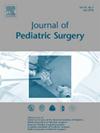Six Years of Quality Improvement in Pectus Excavatum Repair: Implementation of Intercostal Nerve Cryoablation and ERAS Protocols for Patients Undergoing Nuss Procedure
IF 2.4
2区 医学
Q1 PEDIATRICS
引用次数: 0
Abstract
Background
The Nuss procedure for pectus excavatum is associated with prolonged hospitalizations due to pain. We evaluated implementation of intercostal nerve cryoablation and enhanced recovery after surgery (ERAS) protocols on outcomes of Nuss procedures performed over six years at a single institution.
Methods
This retrospective cohort study included patients who underwent Nuss procedure from 10/2017 to 09/2023. Patients received epidurals prior to 06/2019, cryoablation from 06/2019 to 07/2021, and ERAS with cryoablation and intraoperative methadone administration after 07/2021. We used multivariable linear regression to evaluate length of stay (LOS), inpatient morphine milligram equivalents (MMEs), and discharge opioids. We assessed the balancing measures of operative time, postoperative pain scores, and complications.
Results
We identified 62 patients; 15 who received epidurals, 18 cryoablation, and 29 cryoablation with ERAS. Cryoablation was associated with a 62.3% (p < 0.001) decrease in length of stay, an 86.6% (p < 0.001) decrease in inpatient MMEs, and a 72.9% (p < 0.001) decrease in discharge opioids. Cryoablation was additionally associated with 24.5% (p = 0.02) longer operative times and 46.4% (p = 0.04) higher postoperative day one pain scores. Subsequent implementation of an ERAS protocol was associated with a further 82.8% (p = 0.04) decrease in discharge opioids and a 25.0% (p = 0.04) decrease in postoperative day one pain scores.
Conclusions
Over six years of quality improvement efforts, we found the implementation of cryoablation and ERAS protocols to be associated with a significant decrease in length of stay and opioid exposures. Protocolized pain management and cryoablation may work synergistically to improve outcomes without compromising patient experience.
Level of Evidence
Level III – Retrospective comparative study.
胸大肌修复术六年来的质量改进:对接受 Nuss 手术的患者实施肋间神经冷冻消融术和 ERAS 方案
本文章由计算机程序翻译,如有差异,请以英文原文为准。
求助全文
约1分钟内获得全文
求助全文
来源期刊
CiteScore
1.10
自引率
12.50%
发文量
569
审稿时长
38 days
期刊介绍:
The journal presents original contributions as well as a complete international abstracts section and other special departments to provide the most current source of information and references in pediatric surgery. The journal is based on the need to improve the surgical care of infants and children, not only through advances in physiology, pathology and surgical techniques, but also by attention to the unique emotional and physical needs of the young patient.

 求助内容:
求助内容: 应助结果提醒方式:
应助结果提醒方式:


